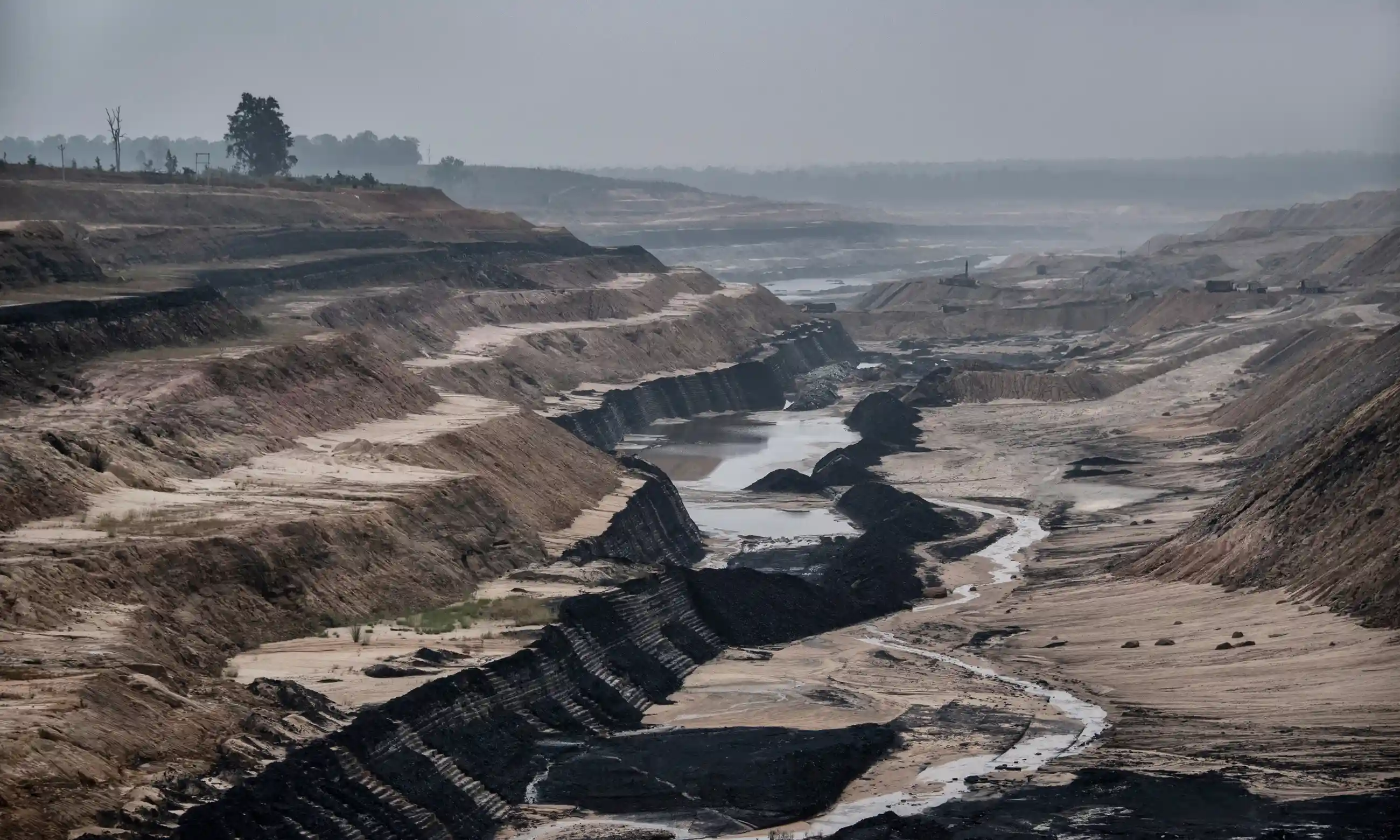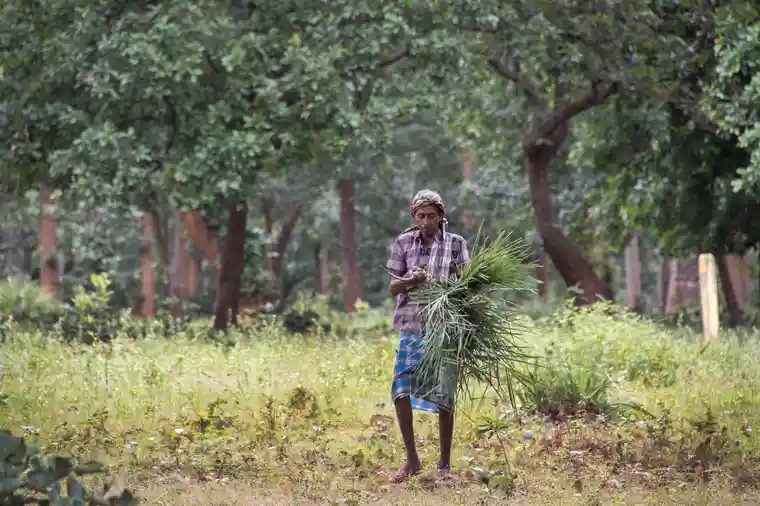“Land is everything for us. Our livelihood, our life; the basis of our identification for every benefit from the state,” said Anil Hembrom. As a farmer from Jharkhand, he refers to the unfair use of fertile land, with mines made from rice and wheat fields. “We labor on our own land and sustain ourselves. There is no way we will give it up,” added the village farmers in solidarity with Hembrom.

This land use conversion comes after November 2020, when Adani Enterprise Limited (AEL) won the Godalpura coal block in a commercial coal auction. With geological reserves of 176 million tonnes of coal, the block proposes to take up 513.18 hectares of land, further tearing into existing fertile farmlands. Set to become operational by 2024, with an estimated cost of INR 9.98 billion, the project is expected to produce 4 million tonnes of coal annually while significantly destabilizing the tribal groups in the region.
India’s drive to maximize coal output across the country to meet the growing energy needs has displaced the Adivasi population (indigenous tribal groups) from their ancestral land and forced them to wait years to be resettled.
This transition leads to an unprecedented rise in structural violence, as a growing number of mining projects continue to violate the rights of India’s minorities. Despite international human rights laws and other established principles that ensure the entitlement of indigenous communities to participate in the decision-making processes that impact their lives and lands, the same continues.
Witnessing the destruction of the fertile multi-crop lands, farmers of Jharkhand fell at their feet, pleading with the Adani personnel to spare the land. “We begged Adani’s people to stop. But they said our land was theirs now, that the government had given it to them,” said Hembrom. If implemented, it remains almost unacknowledged that this multi-billion dollar project is speculated to displace more than 4,000 Gondalpuri villagers while inevitably losing prime agricultural lands. Indeed, “Adivasi communities, who traditionally have strong links to land and forests, have suffered disproportionately from development-induced displacement and environmental destruction in India,” as reported by Amnesty International.
Amidst the relentless intrusion of coal companies into the native spaces, indigenous Adivasi communities are consistently excluded from the decision-making processes that dictate the acquisition of their ancestral land. Indigenous communities, comprising 8% of India’s population, are among the most marginalized communities. Bearing the brunt of an unjust system, many Adivasis face the harsh reality of eviction and inadequate compensation. They endure years of waiting for resettlement as the intrusion of coal companies into their land continues.

“The violations of their rights to consultation and consent – around land acquisition, environmental impacts, indigenous self-governance and the use of traditional lands – has seriously impacted their lives and livelihoods,” said Amnesty International.
Given the formidable challenges, the ‘Rehabilitation Resettlement Bill,’ introduced in December 2007 in the Lok Sabha, the lower house of the Indian Parliament, is a legislative bill compensating people displaced involuntarily or by land acquisitions. Despite its noble intentions, rehabilitation efforts under the bill often fall short of ensuring displaced individuals' long-term development and well-being. While they sometimes may provide some immediate relief, the lack of sustained support hampers the individuals’ ability to rebuild their lives effectively. Further, the bill also comes up short in specifying a timeframe for the rehabilitation, leaving a crucial aspect unresolved.
Although it has generated approximately USD 20.8 billion in revenue, according to the Ministry of Coal’s Annual Report 2021-22, the coal industry consistently undermines the sufferings of the displaced tribal communities across the country. Coal India Limited, a state-owned coal mining company and one of the world’s largest producers, aims to produce an outstanding 1 billion tonnes of coal by 2023-24 by expanding the existing ‘open-cast’ mines, as was announced by Pralhad Joshi, India's Minister of Coal, on the 45th Coal India Foundation Day.
The consequences extend beyond the immediate land acquisition and coal extraction. The rivers that the villagers heavily depend on face an imminent peril of pollution stemming from mining activities. Despite the government's directive that the coal industry must expedite the clearances required to make mines operational, the current trajectory reveals an unsettling proposition. Surprisingly, the government is inclined to waive vital environmental rules that previously held mining companies back from starting new operations.
While some rigid legal provisions are in place to protect the environment, they are not necessarily effective. India's Environmental Protection Act of 1986 is crucial in protecting indigenous communities from environmental hazards. The act mandates that state-level Pollution Control Authorities establish public consultations with local communities likely to be impacted by the environmental consequences of projects. This provision allows them to express any concerns they may have.

Similarly, the Environment Impact Assessment notification of 2006 (amended in 2009) emphasizes the importance of wide public hearings related to environmental matters. It stipulates that the relevant Pollution Control Authority must also include all segments of the population residing in the country. Successive Central governments, however, have attempted to weaken the requirements for public hearings concerning specific categories of mines, further jeopardizing local communities' rights.
It is essential to acknowledge that India has ratified international human rights treaties promising to safeguard fundamental human rights, promote equality, and eliminate discrimination. The International Covenant on Civil and Political Rights (ICCPR) and the International Covenant on Economic, Social, and Cultural Rights (ICESCR) require states to refrain from or prevent forced evictions, a matter that the Adivasi community continues to face. Similarly, the situation goes against the Convention on Elimination of Racial Discrimination (CERD), wherein the coal industry is denying the clause that recognizes the importance of protecting the rights of indigenous people to land, consultation, and participation in decision-making processes.
In spite of these international commitments, it is evident that the authorities of the state-owned company CIL have breached a series of domestic and international laws. This highlights how states often fail to meet internationally agreed human rights standards while balancing the need for industrial development. The pressure of industrial growth often overshadows the rights of marginalized communities; the absence of a robust legal framework and effective enforcement mechanisms contributes to the proliferation of such violations with impunity.
Previously in 2012, the Jharkhand State Pollution Control Board (JSPCB) fervently announced public hearings for a mining project conducted by Central Coalfields Limited (CCL). The JSPCB diligently inscribed notices in English and Hindi newspapers a month before the pivotal hearings. However, the villages of Nagara and Basiya, which stood at the epicenter of the project’s impacts, did not have access to these newspapers. Hence, the villagers found themselves shrouded in darkness, unaware of the looming hearing that would irrevocably shape their future.

Another concerning challenge emerges amidst the aspirations of the Coal Bearing Area Act and Land Acquisition Act – a policy that aims to ensure fair compensation, rehabilitation, and resettlement of those impacted by land acquisition for coal mining and other projects, with the goal of promoting sustainable development and social justice. Villagers are despaired by the lack of consideration towards non-movable assets and common property resources. However, the policy’s inefficacy is evident in the legitimized land acquisitions without consultation. It has contributed to the displaced individuals losing their homes and facing the loss of land, as well as access to natural resources– resources that are vital for their economic survival and well-being.
The rapid expansion of mining operations in the country’s coal reserves has exacerbated the marginalization. It has impoverished indigenous communities, especially in the central and eastern states of Chhattisgarh, Jharkhand, and Odisha. These regions are home to the vast majority of the Adivasi population, who have long resided with India’s lush forests and mineral wealth. Still, more than 50% of the over 20 million people displaced across India were because of the relentless pursuit of mining and industrial projects since 1947.
In addition to the pressing issue of displacement, one significant challenge displaced individuals face is the limited acquisition of skills necessary for alternative off-farm work. This dearth of diversified skills and employment opportunities poses a significant barrier to generating a sustainable income and securing their livelihoods in the long run.
Fueled and alarmed by the unfair land acquisitions, the people of Jharkhand, in a display of unity, have risen to take a stand against the proposed mining project by Adani Enterprise Limited (AEL) – a flagship entity of the Adani Group.

“If the government takes our land from us, we, and our future generations, will be condemned to landlessness forever,” said Hembrom. “Our Adivasi existence will be wiped out.” The Indian government must decelerate its coal production.
To resolve the issue, fair land-for-land compensation for the lost assets must be provided to ensure no further human rights violations and a thorough environmental impact assessment. Furthermore, the requirement of free public hearings and prior consent of communities before seeking land acquisition for mining projects in the future should be considered. Operations to review the ongoing mining projects across India, which identify human rights abuses, must also be conducted. The Adivasi community continues to face the brunt of the coal industry’s ‘full-steam ahead’ mindset. It is imperative that organizations, and the state take into account the human impact of the same.
Edited by the Core Editorial Team
Disclaimer
Any facts, views or opinions are not intended to malign, criticise and/or disrespect any religion, group, club, organisation, company, or individual.
This article published on this website is solely representative of the author. Neither the editorial staff nor the organisation (Political Pandora) are responsible for the content.
Images in this particular article are taken from external sources and are not a property of Political Pandora. The use of these images are not meant for commercial purposes.
While we strive to present only reliable and accurate information, should you believe that any information present is incorrect or needs to be edited, please feel free to contact us.


